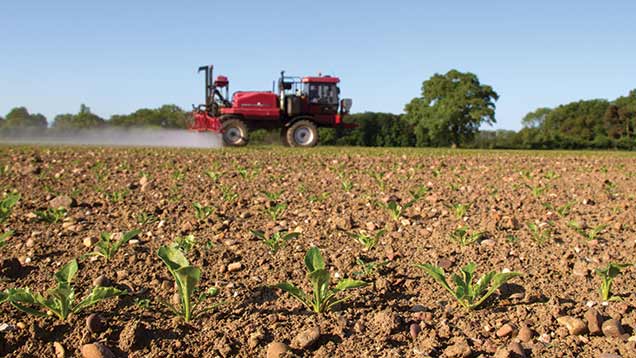Weed out cost from sugar beet herbicide programmes
 ©Tim Scrivener
©Tim Scrivener Sugar beet growers may be able to cut herbicide costs and are urged to review their weed control programmes as the coming season progresses.
Crop price for the new campaign has dropped to £24/t, down from £31.67/t last season and instinct will be to reduce spend on inputs such as chemical.
Many industry commentators believe reducing inputs at the expense of yield would be foolish, urging growers to push for high yields off a smaller area to hit quota.
See also: Cut area and push yield for sweet sugar beet returns
However, UPL technical support manager Pam Chambers says the industry has developed a habit of blanket herbicide applications at high rates, which in some cases is overkill and could be trimmed back.
“We still need to control weeds, even low burdens, as the sugar beet crop always responds well to herbicides. But it’s about spending the money in the right place.
“Many growers will have their first two herbicide sprays planned, but might be able to hold back on further sprays later in the season, so monitoring weeds species and numbers will be crucial,” she adds.
Active ingredients
- Betanal maxxPro, Sniper and Betasana Trio – desmedipham + ethofumesate + phenmedipham
Ms Chambers points to 2012 British Beet Research Organisation (BBRO) trials, in which two adjacent fields at Brooms Barn, Suffolk, had differing burdens of 19 weeds/sq m and 190 weeds/sq m.
Both situations produced a significant yield response to herbicide, but good control of broad-leaved weeds was achieved for a cost of about £80/ha in plots with lower populations.
“In the higher weed burden, that cost can be considerably higher and where blackgrass is in the crop, costs can rise beyond £200/ha.
“But a pansy doesn’t threaten yield as much as volunteer oilseed rape or potatoes, for example, so adequate control could be achieved at a lower cost,” says Ms Chambers.
High price
Herbicides now represent about 70% of the chemical costs in sugar beet – a far higher proportion than for any other crop in the UK – reflecting the importance of weed control.
A shift to early drilling has exposed crops to more broadleaved weed flushes, particularly volunteer oilseed rape, resulting in four post-emergence sprays on many farms.
Herbicide programmes in sugar beet have evolved into several different “systems” (see table below) and Ms Chambers believes the most cost-effective approach is the broadacre system, especially where blackgrass is an issue and a pre-emergence is essential.
It involves two high rate post-emergence applications about two weeks apart, which reduces the number of passes through the crop and the associated fuel, time and labour costs.
“It is slightly more expensive in terms of chemical cost, but the savings made elsewhere will bring it into line with cheaper programmes that involve more applications,” adds Ms Chambers.
The two-spray programme is based on actives desmedipham, ethofumesate, phenmedipham and triflusulfuron, with others added into the mix depending on weed burden.
These would include lenacil for increased contact activity, metamitron for a residual boost and clopyralid for activity on volunteer potatoes and thistles.
All components, apart from desmedipham that only comes in combination phenmedipham, can be combined as single active products.
But Ms Chambers says using co-formulated products such as Betanal maxxPro, Betasana Trio or Sniper can make further efficiency gains when filling the sprayer.
“Singles have more flexibility on rates and can be cheaper, but the one-can options save a lot of time for the operator and that can shave off labour cost.
“It might also be worth considering spot-spraying weeds such as thistles rather than blanket-applying clopyralid, as they often appear in discrete patches within a field,” says Ms Chambers.
Blackgrass woes
The bad news for growers with blackgrass – an increasing problem in sugar beet – is that the opportunity to reduce herbicide spend is taken away, with the importance of preventing seed return crucial for getting on top of the troublesome weed.
A pre-emergence spray is essential, based around ethofumesate for its activity on blackgrass, with metamitron – a stronger option than other approved pre-emergence partners.
Ms Chambers says it is also essential to use a graminicide, such as clethodim, but growers should ensure that it goes on at the correct time to get the most out of it.
“In my opinion, it needs to go on early. By the time you get to canopy closure it is difficult to hit the weed and it is also drier and the weed bigger. It is also essential that it is applied alone,” she adds.
|
Sugar beet herbicide “systems” |
||||
|
System |
Components |
Management |
Weed size |
Flexibility |
|
Standard managed approach |
Contact + residual |
High – Selected for weeds present |
Expanded cotyledon |
10-14 days between sprays |
|
FAR |
F – phenmedipham A – activator R – residual Low rates |
Low – Some input on later sprays |
Early cotyledon |
Meticulous timing every 7-10 days |
|
“Active” – manufacturer programmes |
Formulated products containing several actives + residual |
Medium – Broad spectrum |
Early true-leaf stage |
Flexible spray window |
|
Broadacre |
Debut (triflusulfuron) + high rates of contact and residual actives |
Medium – Broad spectrum |
First true-leaves 1cm |
Aim to use two “big hits” 14 days apart |

